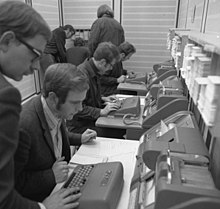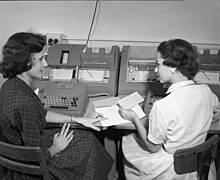Keypunch
A keypunch is a device for precisely punching holes into stiff paper cards at specific locations as determined by keys struck by a human operator.In the 1950s, Remington Rand introduced the UNITYPER, which enabled data entry directly to magnetic tape for UNIVAC systems.Mohawk Data Sciences subsequently produced an improved magnetic tape encoder in 1965, which was somewhat successfully marketed as a keypunch replacement.The rise of microprocessors and inexpensive computer terminals led to the development of additional key-to-tape and key-to-disk systems from smaller companies such as Inforex and Pertec.'Piano machines,' so named for their keys, operated by keyboards and comparable in function to unit record keypunches, became the most common.[9] In 1901 Hollerith patented[10] a mechanism where an operator pressed one of 12 keys to punch a hole, with the card automatically advancing to the next column.The Type 31 Alphabetical Duplicating Punch[16] was introduced by IBM in 1933, and it automatically ejected one card and fed another in 0.65 second.Special function keys such as shift, release, duplication and others, had only electrical contacts under their stems, with no mechanical linkage to the bail assembly for encoding.The heart of the 024 and 026 keypunches was a set of twelve precision punches, one per card row, each with an actuator of relatively high power.The printing mechanism was prone to be damaged if a user attempted to duplicate "binary" cards with non-standard punch patterns.Turning off printing did not actually prevent the damage, as many people assumed, because the code-plate mechanism remained engaged with the punch unit and shifted the code plate.The verifier was similar to the 026 keypunch except for a red error lens in the machine cover lower center.The IBM 056 verifier used most of the same mechanical and electrical components as the 024/026 keypunches with the exception of the punch unit and print head.The more "advanced" reed relays used at first proved to be less reliable than expected, causing IBM to revert to the older-style wire-contact relay-based design.When used in a room also containing 029 keypunch machines, the verifier operators sometimes missed the auditory feedback provided by the loud "thunk" noise emitted by the older 056.Introduced with the System/370 in 1971, the IBM 129 was capable of punching, verifying, and use as an auxiliary, on line, 80 column card reader/punch for some computers.Thanks to its use of electronic memory, the 129 did not have a separate "read station" with a pin-sense unit to enable duplication of data from one card to the next.The central cover on the keypunch could be tilted open toward the operator and a locking lever released, allowing the program drum to be removed and replaced.In 1969, IBM introduced the System/3 family of low-end business computers which featured a new, smaller-sized, 96 column punched card.Their 90-column keypunches used a mechanical system developed by Remington Rand to avoid IBM patent issues (long before the acquisition of Eckert–Mauchly Computer Corporation).[37] This use of the verb has replaced the former process, described[38] as "When a key is struck on a keypunch, it prints the character on the top of the card but also punches a series of holes that the computer"[39] can interpret."In the 1950s, Remington Rand introduced the UNITYPER,[40][41] which enabled data entry directly to magnetic tape for UNIVAC systems.Mohawk Data Sciences subsequently produced an improved magnetic tape encoder in 1965, which was somewhat successfully marketed as a keypunch replacement.In the mid-1970s, the rise of microprocessors and inexpensive computer terminals led to the development of additional key-to-tape and key-to-disk systems from smaller companies such as Inforex and Pertec.






(manufactured by British ICT ) (1960s)














Key duplicationSocial Security AdministrationNew Orleanspunched tapeJacquard loomsprogramHollerith machinesunit record machinespunched cardspunched card input/outputkeyboardsbit bucketdata processingtwo pass verificationdata inputRemington RandUNITYPERdata entrymagnetic tapeUNIVACMohawk Data SciencesInforexPerteccomputer terminalsvideo display terminalstimeshared systemspersonal computersJacquardpantographHerman Hollerithsolenoiddiodesvacuum tubesrelaysdot matrixribbonRaymond LoewyArt DecoIBM 026checkedEBCDICSystem/360SMS cardsIBM Kanji SystemChineseJapaneseKorean languagescharacter setsSystem/370BackspaceFORTRANAssemblerSystem/3United States Census BureauPowers Accounting Machine CompanyEckert–Mauchly Computer Corporationdata entry clerksPunched cardHollerith codeUnit record equipmentComputer programming in the punched card eraList of IBM productsChad (paper)Truesdell, Leon E.Card readerHistoryMergers and acquisitionsPC business acquisition by LenovoProductsMainframePower microprocessorsPower SystemsStorageFlashSystemDS8000Q System OneQ System TwoOspreyCondorBlue GeneCell microprocessorsPowerPCMidrange computerPersonal ComputerSelectricThinkPadCarbon Design SystemCloudantCognos AnalyticsConnectionsCriminal Reduction Utilising Statistical HistoryInformation Management SoftwareLotus SoftwareMainframe operating systemsMashup CenterPlanning AnalyticsPureQueryQuantum PlatformQiskitOpenQASMRational SoftwareTivoli SoftwareService Automation ManagerWatsonWatsonxGraniteWebSphereApptioCenter for The Business of GovernmentConsultingPromontoryKenexaInternational subsidiariesRed HatResearchAdStarAIM allianceKaleida LabsTaligentAmbra ComputerCognosEduQuestKyndrylLexmarkMerativeMicroelectronics